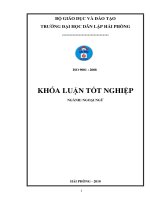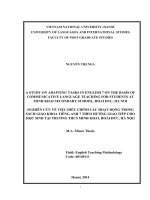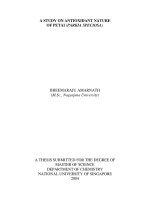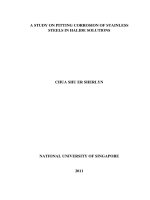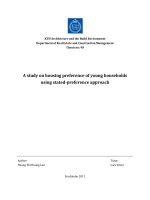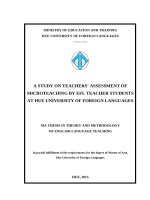A study on semantic features of english set expressions containing words “red” and “green” with the reference to the vietnamese equivalents
Bạn đang xem bản rút gọn của tài liệu. Xem và tải ngay bản đầy đủ của tài liệu tại đây (1.15 MB, 77 trang )
nnnnnnnla AND TRAINING
MINISTRY OF EDUCATION
HANOI OPEN UNIVERSITY
M.A. THESIS
A STUDY ON SEMANTIC FEATURES OF ENGLISH
SET EXPRESSIONS CONTAINING WORDS “RED”
AND “GREEN” WITH REFERENCE TO THE
VIETNAMESE EQUIVALENTS
(NGHIÊN CỨU ĐẶC TRƯNG NGỮ NGHĨA
CỦA NGỮ CỐ ĐỊNH TIẾNG ANH CHỨA TỪ MÀU ĐỎ VÀ XANH
TRONG SỰ LIÊN HỆ VỚI TƯƠNG ĐƯƠNG TIẾNG VIỆT)
NGUYỄN THỊ HÒA
Hanoi, 2016
MINISTRY OF EDUCATION AND TRAINING
HANOI OPEN UNIVERSITY
M.A. THESIS
A STUDY ON SEMANTIC FEATURES OF ENGLISH
SET EXPRESSIONS CONTAINING WORDS “RED”
AND “GREEN” WITH REFERENCE TO THE
VIETNAMESE EQUIVALENTS
(NGHIÊN CỨU ĐẶC TRƯNG NGỮ NGHĨA
CỦA NGỮ CỐ ĐỊNH TIẾNG ANH CHỨA TỪ MÀU ĐỎ VÀ XANH
TRONG SỰ LIÊN HỆ VỚI TƯƠNG ĐƯƠNG TIẾNG VIỆT)
NGUYỄN THỊ HÒA
Field: English Language
Code: 60220201
Supervisor: Assoc.Prof Lê Văn Thanh
Hanoi, 2016
CERTIFICATE OF ORIGINALITY
I, the undersigned, hereby certify my authority of the study project
report entitled A study on semantic features of English set expressions
containing words “Red” and “Green” with reference to the Vietnamese
equivalents submitted in partial fulfillment of the requirements for the
degree of Master in English Linguistics. Except where the reference is
indicated, no other person’s work has been used without due
acknowledgement in the text of the thesis.
Hanoi, 2016
Nguyen Thi Hoa
Approved by
SUPERVISOR
(Signature and full name)
Date:……………………
i
ACKNOWLEDGEMENTS
This thesis could not have been completed without the help and
support from a number of people.
First and foremost, I would like to express my sincere gratitude to Mr.
Le Van Thanh, Ph.D, my supervisor, who has patiently and constantly
supported me through the stages of the study, and whose stimulating ideas,
expertise, and suggestions have inspired me greatly through my growth as
an academic researcher.
My sincere acknowledgement also go to all my lecturers and officers
of Faculty of Graduate Studies,
Hanoi Open University, who have
facilitated me with the best possible conditions during my whole course of
studying.
Last but not least, I am greatly indebted to my family, my friends for
the sacrifice they have devoted to the fulfillment of this academic work.
ii
ABSTRACT
The title of my thesis is a study on semantic features of English set
expressions containing words “red” and “green” and the Vietnamese
equivalents. The purpose of my study is to describe the semantic features of
set expressions containing words red and green colours, show some
similarities and differences between English set expressions containing
words red and green and the Vietnamese equivalents, and propose the
implications for teaching these ones at high school. To carry out this
research, I use descriptive, analytical and contrastive method. Hopefully, the
finding of this study can, to some extent, be suggested as a referential
materials for Vietnamese students and teachers in studying and teaching
colour set expressions.
iii
LIST OF TABLES
Table 4.1. Statistical analyze of semantic filed of English set 44....
expressions containing word “Red”.
Table 4.2. Statistical analyze of semantic filed of English set 50....
expressions containing word “Green”.
Table 4.3. Stastistical analyze of the meaning of English and 51....
Vietnamese set expressions containing word “Đỏ”.
Table.4.4. Statistical analyze of the meaning of English and 52....
Vietnamese set expressions containing word “Xanh”.
Table.4.5. Statistical summary of English set expressions 55....
containing words
“Red” and“Green”
and Vietnamese set
expressions containing words “Đỏ” and “Xanh”.
iv
TABLE OF CONTENTS
Certificate of originality
i
Acknowledgements
ii
Abstract
iii
List of tables
v
Chapter 1: INTRODUCTION
1
1.1.
Rationale for the research
1
1.2.
Aims of the research
2
1.3.
Objectives of the research
3
1.4.
Scope of the research
3
1.5.
Significance of the research
4
1.6.
Structural organization of the thesis
5
Chapter 2: LITERATURE REVIEW
6
2.1.
Review of previous studies
6
2.2.
Review of theoretical background
8
2.2.1. Theoretical framework
8
2.2.2. Theoretical background
11
2.2.2.1. Definition of set expressions
11
2.2.2.2. Classifications of set expressions
14
2.2.2.3. Features of colour set expressions
16
2.2.2.4. An overview of Red and Green colours
18
2.3.
21
Summary
Chapter 3: METHODOLOGY
23
3.1.
Research-governing orientations
23
3.2.
Research methods
25
3.3.
Summary
27
v
Chapter 4: FINDINGS AND DISCUSSION
28
4.1.
37
Semantic features of English set expressions containing words
Red and Green and their Vietnamese equivalents
4.2.
Similarities and differences of English set expressions
50
containing words Red and Green and their Vietnamese
equivalents in term of semantic features
4.2.1. Similarities
50
4.2.2. Differences
54
4.3.
57
Implications
4.3.1. Implications for learning set expressions containing words Red
58
and Green
4.3.2. Implications for teaching set expressions containing words Red
58
and Green
4.3.3. Implications for tranlating set expressions containing words Red 58
and Green
4.4.
Summary
59
Chapter 5: CONCLUSION
60
5.1.
Recapitulation
60
5.2.
Concluding remarks
61
5.3.
Limitation of the research
61
5.4.
Suggestions for a further research
62
REFERENCES
63
APPENDICES
66
vi
Chapter 1
INTRODUCTION
1.1.
Rationale for the research
Nowadays, the globalization has been changing and developing very
quickly; therefore, communication with high requirements has become an
urgent than ever more. Among which English is the most popular and
flexible language in the world. However, in spite of the fact that English has
been the most common one, there stand challenges existing for foreign
learners to overcome. Those difficulties derived from special factors such as
culture, context or even speaker’s implication. They affect to foreign
learners’ understanding as much as possible.
In studying English, especially for the Vietnamese, it is really a
shortcoming if we do not take into consideration of English colour set
expressions. English colours set expressions are not only a part of language,
but also one of the components creating traditional culture of each nation.
Through these set expressions, we can learn more clearly and deeply about
English people, their country as well as their culture.
According to Rod Ellis, one way to help foreign learners of English
overcome their language related problems is to teach them formulaic and
figurative set expressions such as proverbs, idioms, metaphors, phrasal
verbs etc. which are a crucial part of natural language production (Rod Ellis,
2008). Therefore, set expressions containing words “red’ and “green” are
selected as the focus of this study because it is seen that specific
characteristics of culture, and each colour English expression has its own
features.
It lies in the fact that, colours have taken an important role in the
living and each colour also has its own meaning. Therefore, there have been
a lot of studies involved in the meaning of colours set expressions in order
1
to know how to use them. As for Berlin and Kay, the “colour terms” has
been used to show differences in color of each language on over the world.
While we might readily expect differences for words relating to things in
environment such as animal and plants, or for cultural system like
governance or kinship terms, it might seem surprising that terms for colours
should vary. The investigation claims that languages vary in the number and
range of their basic color terms. (Berlin and Kay, 1969) As a result,
knowledge of color set expressions can increase comprehension of texts and
using them can make learners‘verbal and written communication more
effective (Irujo, 1986; Vanyushkina-Holt, 2005).
Being aware of the importance of colour set expressions in daily
interaction as well as in learning language, I decided to choose the thesis
entitled “A study on semantic features of English set expressions containing
words “Red” and “Green” with reference to the Vietnamese equivalent” as
the topic of the master graduation thesis; thus, can help Vietnamese learners
of English understand more clearly about the way of using and translating
them from English to Vietnamese and vice-versa. Hopefully, it will
somehow help Vietnamese learners enrich their knowledge and have a
deeper insight into English colour set expressions. As for the learners of
English or Vietnamese, a contrastive analysis of semantic features of colour
set expressions in this thesis will help them improve the ability of using and
understanding. Especially, the study of all kinds of color set expressions
containing words “red” and “green” are expected to provide the translators
with fresh thinking of culture, lifestyle, custom, notions, which brings their
works to perfection to some extent.
1.2.
Aims of the research
This study is conducted to aim at finding out the typical semantic
features of English set expressions containing words “Red” and “Green”
with reference to the Vietnamese equivalents, thus helping Vietnamese
2
learners of English to have better understanding of these set expressions and
be able to use them effectively in daily communication.
1.3.
Objectives of the research
With a view to achieving the mentioned-above aims, some specific
objectives have been put forward as follows:
(i)
Identify and describe the semantic features of English set
expressions containing words “Red” and “Green”.
(ii)
Point out the similarities and differences of these English set
expressions containing words “Red” and “Green” and their Vietnamese
equivalents in terms of semantic features.
(iii)
Supply some suggested implications for teaching, learning, and
translating English set expressions containing words “Red” and “Green”.
1.4.
Scope of the research
(i)
Academic scope:
English set expressions, especially colour set expressions play an
important part in English and Vietnamese languages because they reflect
cultural and psychological factors. However, due to the time allowance and
limited knowledge, it is impossible to carry out a comprehensive study of all
colour set expressions. In this thesis master, semantic features of English
colour set expressions containing words “Red” and “Green” are extensively
discussed with reference to the Vietnamese equivalents, thus helping us to
propose some possible implications for learning, teaching and translating
these set expressions from English into Vietnamese and vice-versa.
(ii) Social scope:
In the process of completing this research thesis, all the material
collection of English set expressions containing words “Red” and “Green”
and their equivalents in Vietnamese are collected and considered before
3
using with the hope that the outcome of this research thesis, to some extent,
would be able to make a certain contribution to enhance the quality of
communication for Vietnamese language learners.
1.5.
Significance of the research
(i) Theoretical significance:
In terms of theoretical significance, the research is expected to
contribute an in-depth description of English set expressions containing
words “Red” and “Green” when analyzing their semantic features in
comparison with Vietnamese equivalents.
(ii) Practical significance:
In terms of practical significance, English colour set expressions have
been studied in many aspects such as culture, custom, and even psychology
but there are few studies dealing with the semantic features of each colours
as Red and Green colours. Thus, this research is conducted in attempt to
provide Vietnamese learners of English with better mastering how to apply
these colour set expressions in sensible ways, how to thoroughly
understand, and naturally use them in receptive and productive skills. In
describing the semantic features of English set expressions containing words
“Red” and “Green” will be taken into consideration as the ground for my
study with the hope of making a contribution in to the process of
overcoming some difficulties met by the Vietnamese learners of English.
1.6.
Structural organization of the thesis
This study includes five main chapters as follows:
Chapter 1, “Introduction”, provides an overview of the issues to be
covered and the situations in which the study is carried out. The aims, the
specific objectives, the scope, the significance and the structural
organization of the thesis are also presented in this chapter.
4
Chapter 2 named “Literature Review”, discusses the previous studies
on proverbs relating to the area of the research and presents some theoretical
preliminaries that could be used as foundation for the process of conducting
the research.
Chapter 3, “Methodology”, present the research questions and
research approach with various methods and techniques employed for
conducting the whole thesis.
Chapter 4, “Findings and Discussion”, describes and analyses the
semantic features of English set expressions containing words Red and
Green with reference to the Vietnamese equivalents to find out and discuss
the similarities and dissimilarities.
Chapter 5, “Conclusions and Implications”, summaries the major
findings resulted from the investigation and data analysis, presents the
limitations of the study, provides some suggestions for further research and
proposes some possible implications for using these set expressions
containing words “Red” and “Green” from English into Vietnamese.
5
Chapter 2
LITERATURE REVIEW
The literature review serves two main purposes. The first part it gives
a review of previous studies related to English colour set expressions in
general. The second part presents and discusses the theoretical background
which guide and inform this research.
2.1.
Review of previous studies
It could be seen that English colour set expressions considerably play
an important part in linguistic treasure of all nations in the world. That is
one reason that there have been many studies on English colour set
expressions in terms of psychological and cultural factors but few of them
concentrates on some focal and particular colours such as Red and Green.
Therefore, this caused some difficulties for the writer in the process of
researching materials.
2.1.1. Previous studies overseas
In 1953, Lenneberg made an often-cited "strong version" of the claim,
firstly given to the readers who showed concerns to the theory , proposes
that language structure determines how we perceive the world. In this claim,
Lenneberg and his colleague - Roberts presented their paper “The Denota of
Color Terms” at the Linguistic Society of America. In this paper, they
reported their findings on color recall in Zuni speakers. Zuni has one color
term for yellow and orange, and Lenneberg and Roberts' study reported that
Zuni speakers encountered greater difficulty in color recall for these colors
than English speakers, who have available terms to distinguish them. On the
contrary to Lenneberg and Roberts' study, a "weaker version" of this claim
6
posits that language structure influences the world view of speakers of a
given language but does not determine it.
After that, Brown and Lenneberg published “A Study in Language
and Cognition” in 1954, where they discussed the effect of codability on
recognition. Brown and Lenneberg attributed this effect to the property of
codability. Linguistic codability is the ease with which people can name
things and the effects of naming on cognition and behavior. In their
experiment, they used a series of Munsell chips to test color recall and
recognition in English speakers. Their findings suggested that the
availability of a basic color term in a given language affected the retention
of that color in recall testing. In other words, Brown and Lenneberg linked
their study to Lenneberg and Roberts' 1953 findings on color recall in Zuni
speakers.
In 1969, Berlin and Paul Kay carried out a research named “Basic
color terms: their universality and evolution” (published by University of
California Press). This is one important area of discussion has been the
differences in color terms in languages and raised a new theory of
differences for words relating to things in environment such as animals and
plants, or for cultural systems like governance or kinship terms, it might be
surprising that terms for colours should vary. Berlin and Kay investigated
the fact that languages vary in the number and range of their basic color
terms.
The conclusion seems to be that the perception of the colours is the
same for all human beings but that language lexicalize for different naming;
and certainly, all of the previous studies on perception of colours have
raised the issue that there are universals in color naming and thus forms a
critique of the hypothesis of linguistic relativity.
7
2.1.2. Previous studies in Vietnam
As a matter of fact, there have been a lot of studies on idioms have
attracted learners of English such as Bùi Phụng (2003), Thành ngữ Anh
Việt, Nxb Văn hóa thơng tin, Hà nội or Nguyễn Lực, Lương Văn Đang
with “Thành ngữ tiếng Việt” in which a large amount of idioms, their
variants are collected with examples. Besides, “Từ điển Thành ngữ tục ngữ
Việt Nam” by Đặng Hồng Chương is a collection of idioms and proverbs
with explanations of them.
The relativity between colours and languages is not a newly- debated
issue; however, some of these only concentrates on some focal colours, such as
Trần Thị Thu Huyền with “Hoa cỏ và màu sắc trong thành ngữ tiếng Việt”
(2001).
Another study is “Tính biểu trưng của từ ngữ chỉ màu sắc trong tiếng
Việt” by Trinh Thi Minh Huong at Ho Chi Minh Pedagogical University
(2009). In this paper, she also described, analyzed and compared linguistic
and cultural features between English and Vietnamese color words.
After examining the studies mentioned above, it could be seen that so
far there found no studies engaged in the semantic features of English
colour set set expressions with reference to the Vietnamese equivalents in
English although many linguists, grammarians, compilers and researchers
have dealt with color words in Vietnamese. Therefore, these materials have
made a suggestion about the subject of colour set expressions with the
reference in Vietnamese equivalents that still is open subject.
2.2.
Review of theoretical background
2.2.1. Theoretical framework
2.2.1.1.
Theory of Semantics
John Isaeed (1997) posited that Semantics is the study of meaning
communicated through language and “Syntax is the study how words can be
8
combined into a sentence; and semantics is the study of the meanings of
words and sentences”. It could be seen that whereas syntax is the grammar,
structure or order of the elements in a language statement, semantics is the
meaning of these elements. Semantics has a long history of researching as
well as many controversies about its definition but the word “semantics”
made it earliest entry into the Old English Dictionary only in 1890s.
Goddard (1998) remarks that semantics is the systematic study of
meaning, is at the center of linguistic request to understand the nature of
language and human language abilities for two reasons. The first reason is
that expressing meanings is what language is all about – everything from
words to grammatical constructions and structures. The second one is that
semantics can shed the light on the relationship between language and
culture.
The term “linguistic semantics” is used by J. Lyons (1995, xii) and
considered as correspondingly ambiguous because “linguistic semantics”
can be held to refer either to the study of meaning in so far as this is
expressed in language or, alternatively, to the study of meaning within
linguistics. “Linguistics semantics is the study of meaning in so far as it is
systematically encoded in the vocabulary and grammar of natural
languages”. As for CharlesW. Kreidler (1998), there are three disciplines are
concerned with the systematic study of “meaning” itself: psychology,
philosophy, and linguistics. Their particular interests and approaches are
different, yet each borrows from and contributes to the others.
Obviously, “Semantics is the systematic study of meaning of words and
sentences, and linguistic semantic is the study of how language organize and
express meaning” (CharlesW. Kreidler ,1998); hence, it has been the central to
the study of communication and study of the human mind - thought processes,
9
cognition. With this definition, semantics is included under lexicology, the more
general science of words, being its most important branch.
In all cases mentioned above, the linguistic researchers offer different
aspects of Semantics. Different as they are, the definition of Semantics is
more interesting and clear. Due to the scope of this study, semantics aspect
is selected to serve as working researching for the study; therefore, the
findings in chapter IV basically concentrates on semantic findings of set
expressions containing words Red and Green .
2.2.1.2.
Theory of Basic color term hierarchy
One important area of discussion has brought different color terms in
languages is color term hierarchy. While we might readily expect
differences for words relating to things in environment such as animal and
plants, or for cultural systems like governance or kinship terms, it might be
surprising that terms for colours should be vary. In an important study,
Berlin and Kay (1969) investigated the fact that languages vary in the
number and range of their basic color terms and even when there are various
ways of describing colours, including comparison to objects, languages have
some lexemes which are basic.
After having studied 98 languages (20 languages experimentally and
investigating the literature on color term semantics folr 78 additional
languages), Berlin and Kay 1969 presented evidence indicating that all
languages share a universal system of basic color categorization.
Furthermore, their basic experimental found that “color categorization is not
random and the foci of basic color terms are similar in all languages”. On
the other hand, their conclusion drawn in this and subsequent studies is that
color naming systems are based on the neurophysiology of the human visual
system (Kay and Mc Daniel 1978). A further claim is that there are eleven
basic categories; and that these form the implicational hierarchy below:
10
Basic color term hierarchy (Berlin and Kay, 1969):
This hierarchy represents the claim that in a relation A
-
All languages contain terms for white and black.
-
If a language contains three terms, then it contains a term for red.
-
If a language contains four terms, then it contains a term for either
green or yellow (but not both).
-
If a language contains five terms, then it contains a term for blue.
-
If a language contains six terms, then it contains a term for brown.
-
If a language contains eight or more terms, then it contains a term
for purple, pink, orange, grey, or some combination of these.
2.2.2. Theoretical background
2.2.2.1.
Definition of set expressions
According to John Lyons (1995) posited that the expression of a
language fall into two sets. One set, finite in number, is made up of lexically
simple set expressions: lexemes. These are the set expressions that one
would expect to find listed in a dictionary: they are vocabulary-units of a
language, out of which the members of the second set, lexically composite
set expressions, are constructed by means of grammatical (i.e, syntactic and
morphological) rules of the language.
Not all the set expressions listed in a dictionary, however, are words.
Some of them are what traditionally called phrases; and phrasal set
expressions, like word-set expressions.
11
English set expressions have their own phrases and sentences that
used daily in communication, in speech as well as in writing. Furthermore,
“phraseology is the study of set set expressions called phraseological units.
These set set expressions are completely or partially idiomatic in speech as
ready-made unit”. (Đặng Trần Cường, 2001). Set expressions required of
fixed phrases, sentences, idioms and proverbs; in this study the working
definition include proverbs and idioms.
(i)
Definition of proverbs
According to Mieder [21, p.5]
states the commonly quoted
definitions: “A proverb is a short, generally known sentence of the folk
which contains wisdom, truth, morals, and traditional views in a
metaphorical, fixed and memorizable form and which is handed down from
generation to generation”. He also adds that “a proverb is a short sentence of
wisdom”.
In the introduction of The Oxford Concise Dictionary of Proverbs,
Simpson and Speake [32, p.2] bring up the following definition that
“Proverb is a traditional saying which offers advice or presents a moral in a
short or pithy manner”. Also in the definition of Oxford Advanced
Learner’s Dictionary, proverb is “a well-known phrase or sentence that
gives advice or says something that is generally true, for example “Waste
not, want not”.
As for Linda and Roger Flavell [10: p.3], proverb is “a concise
sentence, often metaphorical or alliterative in form, which is held to express
some truth ascertained by experience or observation and familiar to all.
According to Hornby [9, p.1180], "A proverbs is a well known phrase
or sentence that gives advice or says something that is generally truth”.
Or according to Dang Tran Cuong,
“Proverb are historically created folk quotations or sayings, which
express popular wisdom, a truth or moral lesson in a figurative, imaginary
12
way. They have the form of a complete sentence and play the most
important role in phraseological units, as:
-
Their lexical components are also stable, constant;
-
Their meaning is mostly figurative;
-
They are ready-made units.
Many proverbs are peculiar only to the English language, reflecting
national features, history and traditions of the English people.
E.g. He dances well to whom fortune pipes.
You can’t eat what your cake and have it.
Some English proverbs are of international character: they exist in
many languages.
E.g. Two head are better than one.
Don’t cast pearls before swine.
Sometimes they are translation loans from other languages mainly
from French.
Besides, many set expressions are created from proverbs and sayings.
E.g. It is nearly bird that catches the worm – the early beat.
New broom sweeps clean – a new broom.”
[5: p32-33]
In all cases mentioned above, the definitions of proverbs appear in
numerous varieties and different approaching but the one given by Mieder
[21] and the one in the Oxford Advanced Learners’ Dictionary [9] are
selected to serve as working definitions for the study.
(ii)
Definition of idioms
According to Longman Dictionary of English Language and Culture
[8], an idiom is a fixed phrase that has it own special meaning and it is
impossible to guess the meanings from separate words.
13
And in Oxford Advanced Learner’s Dictionary: “An idiom is a phrase
or sentence whose meaning is not clear from the meaning of its individual
words and which must be learn as a whole unit”.
According to Hornby [25, p.771], an idioms is defined as "a group of
words whose meanings is different from the meaning of individual words".
Michael McCarthy Felicity O’Dell [10] consider idioms are set
expressions which have meaning that is not obvious from the individual
words.
As for F.R.Palmer [27], "an idiom is an expression whose meanings
cannot be inferred from the meaning of its parts".
Idioms, in general, are deeply connected to culture. Adam Makkai
[26] defines "an idiom as the assigning of a new meaning to group of words
each of which already has its own meaning” and
“biculturalism and
bilingualism are two sides of the same coin. Engaged in the intertwined
process of culture change, learners have to understand the full meaning of
idioms”.
An idiom is very different from a proverb in that it is not only a
complete sentence but also a phrase. From all of definition of Idioms
mentioned above, idioms can be considered as words, phrases, or set
expressions whose meaning is not predictable from the usual meanings of its
constituent elementsor from the general grammatical rules of a language.
2.2.2.2.
Classifications of set expressions
Generally, it is accepted that there are some ways to classify set
expressions, depending on their meaning (semantically) and structure
(structurally), or the degree of idiomaticity. Basing on the definition of set
expressions which have been mentioned above and the purpose of the study,
the classification of set expressions are concentrated in the field of
semantics.
14
Semantically, the most dominant feature of expression classifications
is their composite unity which consists of empty words. With these ones,
their meanings should be taken symbolically and metaphorically because
they create a very different meaning than their appearance at first glance.
According to Jackson and Ze Amvela [19:66], there are so-called
“pure idioms” which are, in fact, “frozen idioms” that “tend to lose their
vividness and speakers often lose sight of their metaphorical origins”.
Frozen idioms are not widely used by modern English speakers.
Fernando [10:60-63] divided set expressions into three different
groups depending on the degree of semantic isolation and the degree of
opacity as follows:
(1)
Pure idioms
They are opaque to users of language with respect to all or some of
the words that make them up. Formally such idioms are multi-word set
expressions functioning as a single semantic unit whose meaning of
individual words cannot be summed together to produce the meaning of the
whole.
E.g. Smell the rat
This expression means that “becoming suspicious” , not “sense rodent
with olfactory organs”. It is a totally pure idiom because its complete nonliteralness.
(2)
Semi-idioms
The semi-idioms are partial non-literalness because one component
generally preserves its direct meaning.
E.g. A blue film
The word “film” here sustains a direct meaning. But the word “blue”
means that a pornographic film, not the colour.
(3)
Literal idioms
15
Literals idioms can be interpreted on the basis of their parts and the
meanings are transparent. The components of these ones are usually used in
their direct meaning; nevertheless, such combination sometimes requires
figurative sense. E.g. To rub a salt in a wound .
2.2.2.3.
Features of colour set expressions
Each language has its own features, and these features have made the
face, the cultural components of that language. As we know, English
language is more various and flexible than any other ones. Especially,
English has been a global language and called by an exact name “a living
language”. Therefore, English has much more outstanding and individual
characteristics than other languages in the world.
Together with these features, English also has other characteristics
which create cultural and traditional treasure of language, which include
colour set expressions. Because of the own meaning of each colour in the
living of English people, each colour expression also play a special role in
English language as well as the daily life.
It lies in the fact that there are some typical features of colour set
expressions as follows.
First of all, concerning to semantics, like many others English
expression, one of the most outstanding features of English colour set
expressions is that their meanings could be ranged into the three groups:
positive, negative, and neutral meaning.
The second feature of English colour set expressions is that the
structures have no grammatical rules at all. With the viewing from a
syntactic aspect, colour set expressions usually have short and fixed forms
and they form a complete utterance (Norrick, 2007).
For example, “Green around the gills” means that looking sickly
E.g. My friend green around the gills after being heard the news.
16
As we know, colours are very important for the users to express their
feelings so they are frequently associated with various moods or emotional
states. Then, colour set expressions are built up by using name of colours –
and most of them are metaphorical when considering from a literary aspect.
They contain various figures of speech and thus, they are part of figurative
language; prosody is a typical feature of colour set expressions (Norrick,
2007) as they include such stylistic markers as rhyme, alliteration etc.
For example, “To be green with envy” means being so envious that it
almost turn one’s skin to green or sickly
E.g. Daisy was green with envy when she knew you have been
promoted
Or the expression “Make somebody see red” means making
somebody so angry that his/her face turn to red.
E.g. You made him see red with your criticism.
Another feature of English colour set expressions is that each English
colour expression usually contains only one colour. However, some set
expressions can contain a pair of colours and those ones are used in
popularity with such set expressions are White, Black, and Blue.
For example, the set expression “In black and white” means that it is
easy to see what is right and wrong, or another example is the set expression
“Black and blue (all over)” whose meaning are the bruises from appearance.
Thus, considering from a semantic aspect, color set expressions express
wisdom, general truths, morals, traditional views, experiences, observations,
social norms, human nature and behavior accepted by the majority in the
society.
Lastly, considering from a cultural aspect, colour set expressions are a
part of traditional andcultural literacy. They represent values and norms of
the society (Morris, 2003) and their origin is rooted from the cultural history
of a nation or an ethnic.
17


